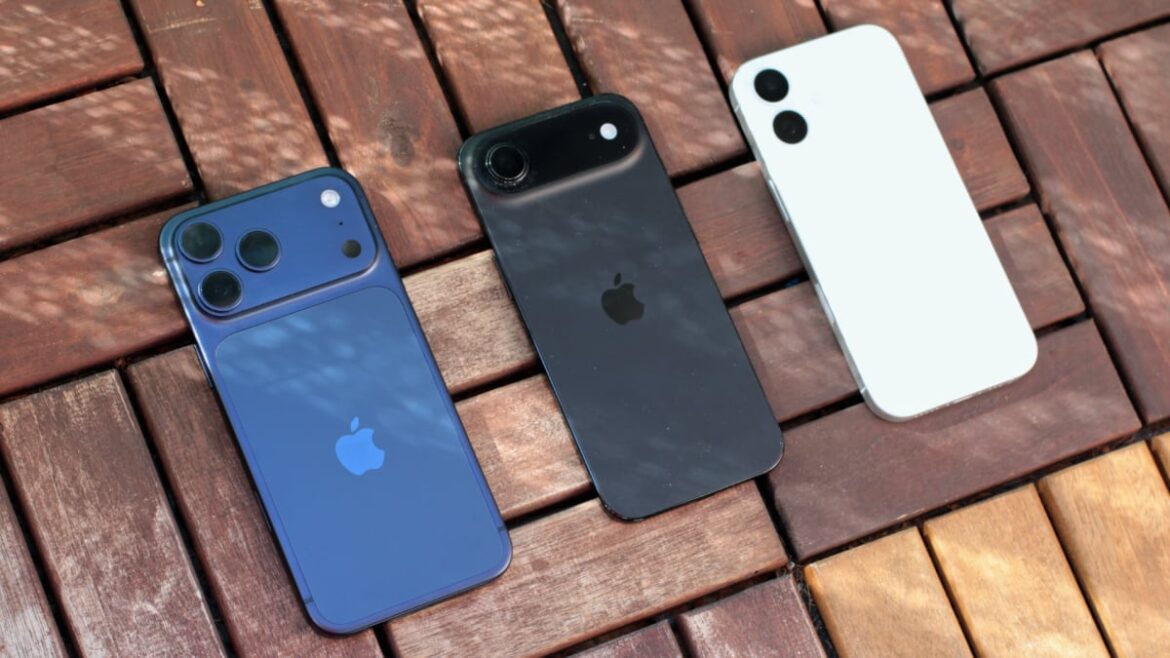Apple’s iPhone lineup has never been this diverse. You have four new phones on offer — iPhone 17, iPhone Air, iPhone 17 Pro, and iPhone 17 Pro Max — with very different designs, dimensions, colors, battery sizes, and camera systems.
And yet, it feels like the iPhone 17 has been upgraded to the point of being a very good option for a lot of buyers; it finally has a 120Hz display, its battery life has been significantly improved, and, just like the other devices, it starts with 256GB of storage. The iPhone Air, on the other hand, has the same chip and display size as the iPhone 17 Pro, but only one camera on the back.
This is why, for a lot of potential buyers, the choice will fall down to the cameras. Apple hyped up the iPhone Air’s single camera as a many-cameras-in-one system, but is it really up to par with the other iPhones, let alone camera powerhouses like the Google Pixel 10 Pro? And is the iPhone 17’s camera system just as good as the one on the Pro models, only without the zoom, or is it noticeably weaker in other areas, too?
Let’s go hands-on and compare some photos to answer all of your questions.
Camera shootout: Daylight

Left to right: iPhone 17 Pro Max, iPhone 17, iPhone Air. In daylight, at maxed out resolution, the differences between the three phones are almost non-existent.
Credit: Stan Schroeder/Mashable
I’m happy to report that all three cameras take wonderfully detailed daylight shots with accurate colors. Turn up the megapixel count to 48 if you want more details, but only do so when the light conditions are just right.
TL:DR: A three-way tie.
Camera shootout: Zoom

Left to right: iPhone 17 Pro Max, iPhone 17, iPhone Air. Again, without zooming in, you’ll get very similar photos across the three devices.
Credit: Stan Schroeder/Mashable
There’s no real competition here: The iPhone 17 Pro and Pro Max have a telephoto camera capable of 4x optical zoom, while the iPhone 17 and iPhone Air simply do not have that lens. Still, you can zoom in on all three phones (yes, even past the default 2x) as Apple will take the zoomed-out photo out of the larger, 48-megapixel capture.

Left to right: iPhone 17 Pro Max, iPhone 17, iPhone Air. The level of detail and sharpness you get on the Pro Max is vastly better than the digital zoom on the other two phones. Still, the iPhone Air consistently performed a little better than the iPhone 17.
Credit: Stan Schroeder/Mashable
As you can see above, the photos without the dedicated telephoto camera simply cannot measure up to the level of detail you get on the iPhone 17 Pro Max, especially at 8x magnification. Interestingly, I’ve gotten slightly better results with the iPhone Air than with the iPhone 17. This was quite consistent over various set-ups and zoom levels, indicating that the Air has a better overall main camera than the iPhone 17.
TL;DR: The iPhone 17 Pro Max wins in this category, which is no surprise. What is a surprise? The iPhone Air beat the iPhone 17.
Mashable Light Speed
Camera shootout: Ultra-wide

Left:
Credit: Stan Schroeder/Mashable
Right:
Left: iPhone 17 Pro Max, Right: iPhone 17. Sometimes the scenery demands an ultra-wide photo, and the iPhone Air just doesn’t have the option.
Credit: Stan Schroeder/Mashable
Only the iPhone 17 Pro Max and the iPhone 17 have the ultra-wide camera; the iPhone Air doesn’t even have the option to zoom out past the default, 1x setting. On both the iPhone 17 and the iPhone 17 Pro Max, the ultra-wide yields significantly blurrier photos than the wonderfully sharp main shooter, so I recommend avoiding it. However, sometimes you just have to use it — typically, when you need to place a large group of people within the frame — and that’s where the option is great to have, photo quality be damned.
TL;DR: The iPhone 17 and iPhone 17 Pro Max have a decent but not great ultra-wide camera; the Air lacks this altogether.
Camera shootout: Low light

Left to right: iPhone 17 Pro Max, iPhone 17, iPhone Air. This nocturnal scene was captured beautifully by all three phones. The one taken with the iPhone Air has the most accurate colors, but differences are minute.
Credit: Stan Schroeder/Mashable
I was particularly interested in low-light performance, as this is where you really see whether the iPhone 17 and iPhone Air can hold their own against the Pro Max’s powerful main camera. I’m happy to report that nighttime photos turned out roughly the same, no matter if I used the iPhone 17, iPhone Air, or iPhone 17 Pro Max.
TL;DR: All three phones took low-light photos of roughly the same quality.
Camera shootout: Macro

Left to right: iPhone 17 Pro Max, iPhone 17, iPhone Air. The photos taken by the iPhone 17 and 17 Pro Max are almost identical. The iPhone Air simply cannot capture as many details up close.
Credit: Stan Schroeder/Mashable
This test is perhaps unfair towards the iPhone Air, which doesn’t have a dedicated macro mode. But it’s still worth comparing the results, just to show how better the other two phones are when it comes to this specific photography type.
The iPhone 17 and the iPhone 17 Pro Max automatically switched to macro mode when I came in close to the flower, and both took a beautiful, detailed macro photo with vivid colors. With the iPhone Air, going in this close would only yield a blurry photo, so I used the 2x zoom option to get a bit more detail out of the flower. It’s not bad, but it’s also nowhere near the quality of the other two photos when it comes to details. Also, the iPhone Air decided to blur the background, leaving me with a portrait photo; it’s not bad, but not exactly what I needed here.
TL;DR: The iPhone 17 and iPhone 17 Pro Max excel at macro photography; the iPhone Air doesn’t even have a macro mode.
Camera shootout: Selfie

Left to right: iPhone 17 Pro Max, iPhone 17, iPhone Air. In Croatia, we do not smile. Apparently.
Credit: Stan Schroeder/Mashable
On paper, all three cameras should be the same, and judging by the selfies I took, they pretty much are. I’ve taken a number of selfies with all three phones and they’re always true-to-life with accurate colors and tons of detail. Here, I’ve chosen a portrait selfie which turned out very similar across all three phones.
TL;DR: A three-way tie.
The iPhone 17 vs. the iPhone Air vs. the iPhone 17 Pro Max: Which is best for photography?

They’re all pretty good, but the iPhone 17 Pro Max has the most versatile camera.
Credit: Stan Schroeder/Mashable
The good news is that the main camera appears to be very similar across all three phones, and the iPhone Air performed much better than I expected. For your bread-and-butter daylight photos, as well as low-light shots, nature shots, and selfies, you can choose any of these phones and be happy.
Being able to zoom out and in (especially in) does make a difference in photography. Also, the video capabilities of the iPhone 17 Pro Max are truly pro-grade, compared to the more basic (yet still very good) video shooting you get on the other two phones. If you like to tinker with settings, need tons of storage for videos (the iPhone 17 Pro Max goes up to 2TB), and use zoom a lot, then the iPhone 17 Pro Max is a must.
How we tested
The rules of this contest were simple. I took photos in a multitude of scenarios with all three phones, doing my best to use similar settings and take the photo from the exact same position. Then, I uploaded the photos to my computer to see just how different they looked. In this article I’ve used cropped up details from each set of photos to highlight the differences between each phone.
This is not a perfect test. Sometimes you’ll get a bad (or a surprisingly good) photo for no apparent reason. I did take several sets of photos in each scenario to confirm the differences I saw were real, but I’ve only used a single set of photos for each scenario for the purposes of this article.

